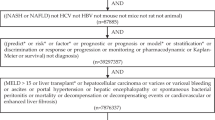Abstract
Background
Prior studies have demonstrated that existing risk stratification guidelines for the evaluation of suspected choledocholithiasis lack accuracy, leading to the overutilization of endoscopic retrograde cholangiopancreatography (ERCP). The aim of our study was to evaluate the performance characteristics of published guidelines in predicting choledocholithiasis and to determine the impact of laboratory trends on diagnostic accuracy.
Methods
We identified patients with suspected choledocholithiasis hospitalized over a 5-year period (2009–2014) at a tertiary care academic medical center. Among eligible patients, we assessed the performance characteristics of the American Society for Gastrointestinal Endoscopy (ASGE) guidelines predicting the presence of choledocholithiasis, confirmed by endoscopic ultrasound, magnetic resonance cholangiography, ERCP, or intra-operative cholangiography. We also evaluated whether a second set of liver function tests improved the accuracy of the guidelines.
Results
On presentation, 71 of the 173 eligible patients (41.4 %) met ASGE high-probability criteria for choledocholithiasis. Of these, only 39 (54.9 %) were found to have a choledocholithiasis on confirmatory testing. Conversely, of the 102 patients (58.6 %) who were classified as low or intermediate probability, 32 (31.4 %) had choledocholithiasis. Overall, the accuracy of the guidelines was 63 % (sensitivity 54.9 %; specificity 68.6 %). Incorporating a second set of laboratory tests did not improve accuracy (62.7 %), and a significant decline in liver function tests did not reliably predict spontaneous stone passage.
Conclusions
Existing guidelines performed suboptimally for predicting choledocholithiasis in our patient population, similar to other validation studies. These findings further underscore the importance of developing alternate risk stratification tools for choledocholithiasis, aiming to minimize unnecessary diagnostic ERCP.
Similar content being viewed by others
References
Everhart JE, Ruhl CE (2009) Burden of digestive diseases in the United States part I: overall and upper gastrointestinal diseases. Gastroenterology 136(2):376–386. doi:10.1053/j.gastro.2008.12.015
Martin DJ, Vernon DR, Toouli J (2006) Surgical versus endoscopic treatment of bile duct stones. Cochrane Database Syst Rev 2:CD003327. doi:10.1002/14651858.CD003327.pub2
Freeman ML (2012) Complications of endoscopic retrograde cholangiopancreatography. Tech Gastrointest Endosc 14(3):148–155. doi:10.1016/j.tgie.2012.06.001
Anderson MA, Fisher L, Jain R, Evans JA, Appalaneni V, Ben-Menachem T, Cash BD, Decker GA, Early DS, Fanelli RD, Fisher DA, Fukami N, Hwang JH, Ikenberry SO, Jue TL, Khan KM, Krinsky ML, Malpas PM, Maple JT, Sharaf RN, Shergill AK, Dominitz JA (2012) Complications of ERCP. Gastrointest Endosc 75(3):467–473. doi:10.1016/j.gie.2011.07.010
Maple JT, Ben-Menachem T, Anderson MA, Appalaneni V, Banerjee S, Cash BD, Fisher L, Harrison ME, Fanelli RD, Fukami N, Ikenberry SO, Jain R, Khan K, Krinsky ML, Strohmeyer L, Dominitz JA (2010) The role of endoscopy in the evaluation of suspected choledocholithiasis. Gastrointest Endosc 71(1):1–9. doi:10.1016/j.gie.2009.09.041
Adams MA, Hosmer AE, Wamsteker EJ, Anderson MA, Elta GH, Kubiliun NM, Kwon RS, Piraka CR, Scheiman JM, Waljee AK, Hussain HK, Elmunzer BJ (2015) Predicting the likelihood of a persistent bile duct stone in patients with suspected choledocholithiasis: accuracy of existing guidelines and the impact of laboratory trends. Gastrointest Endosc. doi:10.1016/j.gie.2014.12.023
Cohen S, Bacon BR, Berlin JA, Fleischer D, Hecht GA, Loehrer PJ Sr, McNair AE Jr, Mulholland M, Norton NJ, Rabeneck L, Ransohoff DF, Sonnenberg A, Vannier MW (2002) National Institutes of Health State-of-the-Science Conference Statement: ERCP for diagnosis and therapy, January 14–16, 2002. Gastrointest Endosc 56(6):803–809. doi:10.1016/S0016-5107(02)70351-9
Rubin MIN, Thosani NC, Tanikella R, Wolf DS, Fallon MB, Lukens FJ (2013) Endoscopic retrograde cholangiopancreatography for suspected choledocholithiasis: testing the current guidelines. Dig Liver Dis 45(9):744–749. doi:10.1016/j.dld.2013.02.005
Sherman JL, Shi EW, Ranasinghe NE, Sivasankaran MT, Prigoff JG, Divino CM (2015) Validation and improvement of a proposed scoring system to detect retained common bile duct stones in gallstone pancreatitis. Surgery 157(6):1073–1079. doi:10.1016/j.surg.2015.01.005
Lee YT, Chan FKL, Leung WK, Chan HLY, Wu JCY, Yung MY, Ng EKW, Lau JYW, Sung JJY (2008) Comparison of EUS and ERCP in the investigation with suspected biliary obstruction caused by choledocholithiasis: a randomized study. Gastrointest Endosc 67(4):660–668. doi:10.1016/j.gie.2007.07.025
Jovanovic P, Salkic NN, Zerem E (2014) Artificial neural network predicts the need for therapeutic ERCP in patients with suspected choledocholithiasis. Gastrointest Endosc 80(2):260–268. doi:10.1016/j.gie.2014.01.023
Rickes S, Treiber G, Monkemuller K, Peitz U, Csepregi A, Kahl S, Vopel A, Wolle K, Ebert MP, Klauck S, Malfertheiner P (2006) Impact of the operator’s experience on value of high-resolution transabdominal ultrasound in the diagnosis of choledocholithiasis: a prospective comparison using endoscopic retrograde cholangiography as the gold standard. Scand J Gastroenterol 41(7):838–843. doi:10.1080/00365520500515370
Author information
Authors and Affiliations
Corresponding author
Ethics declarations
Disclosures
Drs. Alejandro L. Suarez, Nicolas T. LaBarre, Peter B. Cotton, K. Mark Payne, Gregory A. Coté, and B. Joseph Elmunzer have no conflicts of interest or financial ties to disclose.
Rights and permissions
About this article
Cite this article
Suarez, A.L., LaBarre, N.T., Cotton, P.B. et al. An assessment of existing risk stratification guidelines for the evaluation of patients with suspected choledocholithiasis. Surg Endosc 30, 4613–4618 (2016). https://doi.org/10.1007/s00464-016-4799-8
Received:
Accepted:
Published:
Issue Date:
DOI: https://doi.org/10.1007/s00464-016-4799-8




